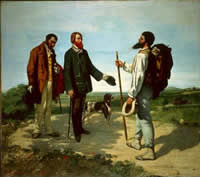
Bonjour Monsieur Courbet, 1854
Huile sur toile - 129 x 149 cm
Montpellier, Musée Fabre
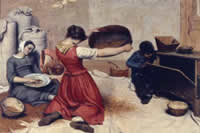
"Les Cribleuses de blé",
1854, huile sur toile,
131 x 167 cm.
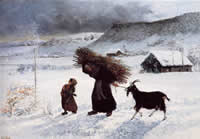
Poor Woman of the Village
(1819-1877)
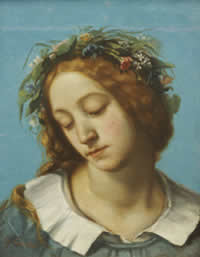
Ophelia. Ophelie
(La Fiancee de La Mort), 1842
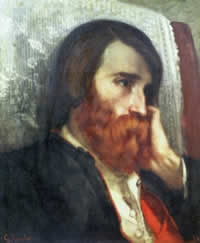
Portrait of Alfred Bruyas
|
Historical Artist - Gustave Courbet (1819 - 1877)
Gustave Courbet was born in Ornans which later became a favourite subject in his paintings. Gustave Courbet studied under several minor artists, and also copied works in the Louvre to establish his own realist style. He went to Paris in 1839, and worked at the studio of Steuben and Hesse. An independent spirit, Gustave Courbet soon left, preferring to develop his own style by studying Spanish, Flemish and French painters and painting copies of their work. A trip to the Netherlands in 1847 strengthened Courbet's belief that painters should portray the life around them, as Rembrandt, Hals, and the other Dutch masters had done.
Gustave Courbet won a gold medal at a Salon exhibition in 1949, but his success diminished after his presentation of The Burial at Ornans, a piece which was considered shallow, ugly, and excessively large. Because the French Government became suspicious of him during the 1848 Revolution, Courbet held contempt for his native country for the remainder of his life. He refused to exhibit at the World Fair in 1855, and also refused to accept the Legion of Honor offered to him. Because of these actions, Courbet was exiled and spent the last years of his life in Switzerland.
Best known as an innovator in Realism, Gustave Courbet was a painter of figurative compositions, landscapes and seascapes. He also worked with social issues, and addressed peasantry and the grave working conditions of the poor. His work belonged neither to the predominant Romantic nor Neoclassical schools. Gustave Courbet believed the Realist artist's mission was the pursuit of truth, which would help erase social contradictions and imbalances.
Towards the end of the 1860s, Gustave Courbet painted a series of increasingly erotic works, culminating in The Origin of the World (L'Origine du monde) (1866), depicting female genitalia, and The Sleepers (1866), featuring two women in bed. While banned from public display, the works only served to increase his notoriety. On 14 April 1870, Gustave Courbet established a "Federation of Artists" (Fédération des artistes) for the free and uncensored expansion of art.
Gustave Courbet's refusal of the cross of the Legion of Honour offered to him by Napoleon III made him immensely popular with those who opposed the current regime, and in 1871 under the revolutionary Paris Commune he was placed in charge of all the Paris art museums and saved them from looting mobs. For his insistence in executing the Communal decree for the destruction of the Vendôme Column, he was designated as responsible for the act and accordingly sentenced on 2 September 1871 by a Versailles court martial to six months in prison and a fine of 500 francs.
Gustave Courbet died, age 58, in La Tour-de-Peilz, Switzerland, of a liver disease aggravated by heavy drinking on 31 December 1877.
Quotes by Gustave Courbet on Art
" I have studied the art of the masters and the art of the moderns, avoiding any preconceived system and without prejudice. I have no more wanted to imitate the former than to copy the latter; nor have I thought of achieving the idle aim of art for art's sake. No! I have simply wanted to draw from a thorough knowledge of tradition the reasoned and free sense of my own individuality."
" To know in order to do: such has been my thought. To be able to translate the customs, ideas, and appearance of my time as I see them - in a word, to create a living art - this has been my aim."
" I, who believe that every artist must be his own master, cannot think of becoming a teacher."
" I cannot teach my art, nor the art of any school, since I deny that art can be taught, or, in other words, maintain that art is completely individual, and that the talent of each artist is but the result of his own inspiration and his own study of past tradition. I add that, in my opinion, art or talent, for an artist, is merely a means of applying his personal faculties to the ideas and the things of the period in which he lives."
" I hold also that painting is an essentially concrete art, and can consist only of the representation of things both real and existing. It is an altogether physical language, which, for its words, makes use of all visible objects. An abstract object, invisible or nonexistent, does not belong to the domain of painting."
" Imagination in art consists in finding the most complete expression for an existing thing, but never in imagining or creating this object itself."
" The beautiful is in nature, and it is encountered under the most diverse forms of reality. Once it is found it belongs to art, or rather to the artist who discovers it. Once the beautiful is real and visible it contains its artistic expression. He trifles with it at the risk of denaturing, and so weakening, it. Beauty as given by nature is superior to all the conventions of the artist."
" Beauty, like truth, is relative to the time when one lives and to the individual who can grasp it. The expression of beauty is in direct ratio to the power of conception the artist has acquired ...There can be no school; there are only painters."
Contemporary French Artists
Art Galleries in France |
